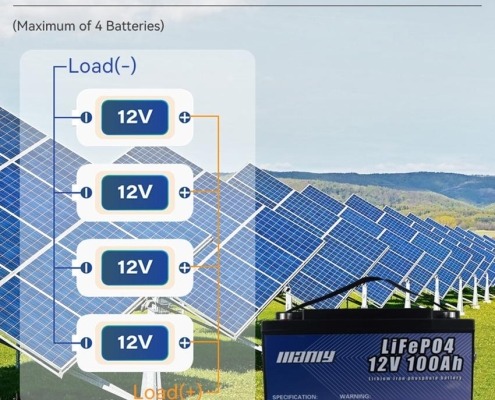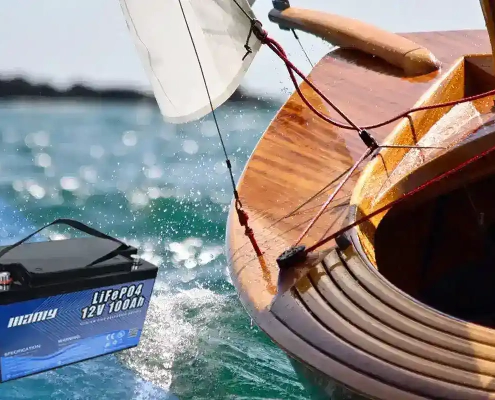Best Lithium Battery for Garmin LiveScope
Table of Contents
- Best Lithium Battery for Garmin LiveScope
- What Is Garmin LiveScope and Why Does It Need a Special Battery?
- Why Use a Lithium Battery for Garmin LiveScope Instead of Lead‑Acid?
- What Voltage and Capacity Work Best for Garmin LiveScope?
- Which Type of Lithium Battery for Garmin LiveScope Performs Best?
- What Are the Best Lithium Battery Brands for Garmin LiveScope?
- Conclusion
- FAQ
- Learn More About Battery
Choosing the right lithium battery for Garmin LiveScope isn’t just about runtime—it’s about voltage stability, reliability, and performance on the water. Whether you’re a weekend angler or a professional outfitter, using the wrong battery can lead to sonar resets, screen flicker, and shortened lifespan. This guide compares power demands, battery chemistries, and the best lithium battery for Garmin LiveScope—including side-by-side data on MANLY Battery, Amped Outdoors, Dakota, Norsk, and Garmin’s own OEM unit. For those seeking longer trips, faster charging, or better cold-weather performance, the right livescope battery makes all the difference.
What Is Garmin LiveScope and Why Does It Need a Special Battery?
Garmin LiveScope operates as a real-time sonar imaging system, continuously scanning and updating underwater visuals. This constant processing requires a clean and stable power supply—making a lithium battery for garmin livescope an operational necessity. Unlike standard marine electronics, LiveScope demands higher voltage and sustained current, which typical 12V lead-acid units struggle to provide over extended periods.
1. How LiveScope Works and Its Power Demand
LiveScope uses a combination of transducers and high-speed processors to deliver real-time sonar views. This setup typically draws between 2–5 amps per hour, depending on the model and screen brightness. A widely shared benchmark from user testing shows that a 9″ LiveScope combo paired with a 16.5Ah battery delivers about 7 hours of runtime at maximum brightness.
When paired with additional chartplotters or networking modules, the current draw can exceed 7–8 amps. In these cases, even a high-capacity 12V AGM battery may struggle to last a full fishing day, especially under continuous high-resolution operation.
Power Draw Summary
- 9″ LiveScope + single chartplotter: ~2.25 A
- Multi-unit setups: up to 8 A
- Runtime target: ≥8 hrs
- Recommended battery: 16v lithium battery or high-output 12v lithium battery for livescope
2. What Happens If You Use the Wrong Battery?
Using an incompatible power source with LiveScope can lead to performance loss and equipment risks. Below are the most common issues tied to underperforming batteries:
- Voltage instability: Cheap or over-discharged units often drop below the LiveScope’s required voltage threshold. This causes screen flickering or full system resets.
- Limited runtime: A 12V battery rated at 10–12Ah may last less than 4 hours under load, especially with multi-unit Garmin setups.
- Premature degradation: Deep discharges damage lead-acid batteries, reducing cycle life to under 300 cycles—versus 3000+ cycles for a quality LiFePO4 unit.
- Thermal or electrical hazards: Overloaded low-cost lithium packs without advanced BMS (Battery Management System) risk overheating, cell imbalance, or even short-circuiting.
3. Why the Right Lithium Battery Makes a Difference
A properly matched livescope battery—whether a 16v lithium battery or a 12v lithium battery for livescope—ensures the sonar system performs at peak levels throughout the trip. The benefits include:
- Voltage stability under high draw
- Longer cycle life, often exceeding 3000–6000 cycles with LiFePO4 cells
- Lightweight construction, improving boat balance and gear portability
- Lower long-term cost, due to fewer replacements and higher energy throughput
- Built-in BMS, which prevents over-discharge, overcurrent, and thermal runaway
For professional system integrators and fleet installers, the best lithium battery for garmin livescope is one that meets these specs:
- Minimum: 16.5Ah usable capacity
- Discharge current: ≥8A continuous
- Voltage stability: ≥12.5V under load
- BMS with low-temperature and short-circuit protection
Why Use a Lithium Battery for Garmin LiveScope Instead of Lead‑Acid?
Lithium batteries outperform lead-acid across every metric that matters for LiveScope performance and long-term system reliability. For any LiveScope setup, a properly matched lithium battery for garmin livescope is essential to deliver voltage stability, runtime efficiency, and lifecycle value.
1. Voltage Stability Ensures Continuous Imaging
Lead-acid batteries experience voltage drop as they discharge, often dipping below the LiveScope system’s minimum operational threshold. This results in dimmed displays, signal loss, or full system reboots. By contrast, a 16v lithium battery or regulated 12v lithium battery for livescope maintains consistent voltage output until nearly depleted, supporting uninterrupted sonar imaging and stable screen brightness throughout usage.
2. Lightweight Design Improves System Integration
Most lithium units weigh 50–70% less than their lead-acid counterparts with comparable capacity. This makes them easier to mount on small boats or kayaks and reduces load strain on mounts or internal compartments. In ice fishing scenarios, where portability is critical, the reduced weight can significantly improve mobility.
Example:
- 12V 30Ah AGM battery: ~24 lbs
- 12V 30Ah LiFePO4 battery: ~9 lbs
3. Greater Usable Capacity for Longer Runtime
Lead-acid batteries should only be discharged to 50% to preserve cycle life, limiting usable energy. In contrast, LiFePO4 cells provide 95–100% usable capacity. That means a 30Ah lithium battery delivers nearly double the runtime of a 30Ah AGM.
| Battery Type | Rated Capacity | Usable Capacity | Estimated Runtime (5A Draw) |
| AGM Lead-Acid | 30Ah | 15Ah | ~3 hours |
| Lithium (LiFePO4) | 30Ah | 28–30Ah | ~6 hours |
4. Longer Lifecycle Reduces Replacement Costs
A livescope battery based on LiFePO4 chemistry typically delivers over 3000 charge/discharge cycles at 80% depth of discharge. In comparison, standard AGM batteries may only last 300–500 cycles under similar conditions. For frequent users or commercial operators, this translates into major savings on battery replacements, reduced downtime, and better long-term ROI.
5. Field-Verified Benefits for Anglers and Installers
A lithium-powered system provides tangible performance advantages in demanding fishing and marine environments:
- No sonar interruptions from low voltage
- Faster recharge times and higher charging efficiency
- No acid leaks or maintenance needs
- Improved cold-weather reliability for winter angling
- Smaller form factor supports flexible mounting
As one LiveScope user noted:
“Lithium charges faster, weighs less, gives longer runtime, and lasts thousands of cycles—no brainer for anyone running sonar full-day.”
What Voltage and Capacity Work Best for Garmin LiveScope?
Understanding the right battery voltage and capacity ensures your system delivers continuous imaging without failures—even under heavy use.
1. Garmin’s Input Voltage and Power Requirements
Garmin recommends a 10–32V input range for LiveScope modules, but real-world performance improves with a higher nominal voltage. A 14.8–16v lithium battery provides a 15–20% boost in efficiency compared to a standard 12.8V pack at the same Ah rating. This is especially important for minimizing amp draw and maximizing screen brightness on chartplotters like ECHOMAP and GPSMAP.
2. Recommended Capacity Based on Usage Level
| Use Case | Recommended Capacity | Estimated Runtime |
| Light use (1 device) | 20–30Ah | 6–10 hours |
| Medium use (LiveScope + GPS) | 40–50Ah | 8–12 hours |
| Heavy use (multiple units) | 60Ah+ | Full-day operation |
For most anglers, a 50Ah LiFePO4 offers a reliable balance between runtime and portability. For integrators building fleet or OEM systems, upsizing to 60Ah or 100Ah enhances system headroom and lifespan.
3. Common Mistakes to Avoid in Battery Selection and Setup
Selecting the wrong battery or wiring configuration can compromise system performance or even cause hardware damage. Avoid these issues:
Under-sizing the Battery
Using a small-capacity battery that doesn’t meet your LiveScope’s current draw can cause voltage sag and system shutdown within hours. Always size based on total amp draw and desired runtime.
Ignoring Voltage Efficiency
A 16v lithium battery maintains higher operational voltage under load, improving sonar clarity and reducing current draw. It’s particularly useful in high-amp setups with dual displays or integrated radar.
Skipping Proper Wiring Practices
- Use 10 AWG or thicker cable to minimize voltage drop.
- Run separate positive lines from the battery to the display and GLS10 module.
- Avoid shared bus bars that introduce interference.
Assuming Alternator Charging Is Sufficient
Many lithium batteries don’t recharge properly through engine alternators without a DC-to-DC charger or BMS-compatible charge controller. Always verify charging compatibility if running a dual-bank system.
Neglecting Cold Weather Ratings
For ice fishing or northern climates, choose a lithium battery for garmin livescope rated for sub-zero charging and discharging. Look for cells with a working range down to –20°C and BMS protection for cold environments.
Which Type of Lithium Battery for Garmin LiveScope Performs Best?
Choosing the right battery chemistry is critical to ensure consistent LiveScope performance, safety, and value over time. Two main options—LiFePO4 and NMC—offer distinct trade-offs in cycle life, energy density, and operational reliability.
1. LiFePO4 vs NMC: Technical Comparison
Each chemistry has its advantages depending on use case and system requirements. Here’s how they compare across key metrics relevant to livescope battery performance:
| Feature | LiFePO4 | NMC |
| Energy Density | 100–150 Wh/kg | 150–200 Wh/kg |
| Cycle Life | 3,000–6,000+ cycles | 2,000–2,500 cycles |
| Usable DoD | 100% | 80–90% |
| Cost per kWh | Lower (iron-based materials) | Higher (nickel/cobalt required) |
| Thermal Stability | High – resists fire & overheat | Lower – more sensitive to abuse |
| Voltage Curve | Flat – steady discharge | Sloped – performance degrades over time |
| Cold Temp Tolerance | Acceptable above –4°F / –20°C | Better below –10°F / –23°C |
Note: Both chemistries support typical Garmin input (10–32V), but voltage behavior under load differs significantly.
2. Safety, Reliability, and Environmental Considerations
LiFePO4 remains the top choice for system integrators prioritizing safety and long service life:
- Thermal Safety: LiFePO4 is chemically more stable, reducing risk of thermal runaway or venting under high loads.
- Lifecycle Value: With >3,000 full cycles, it reduces long-term replacement cost—ideal for seasonal or year-round use.
- Material Advantage: Free from cobalt and nickel, LiFePO4 is easier to recycle and poses fewer environmental hazards.
In contrast, NMC delivers a better weight-to-capacity ratio, which can be useful for portable sonar kits or space-constrained installations. However, its lower cycle life and higher thermal risk make it less suitable for prolonged marine deployments.
3. Voltage Profile Impact on LiveScope
LiFePO4 batteries maintain voltage near 13.2–13.4V throughout discharge, which keeps sonar displays stable until nearly empty. NMC batteries, though starting near 14.8V, drop off more steeply, especially under load, leading to earlier shutdowns unless oversizing is applied.
For applications requiring a 16v lithium battery, some NMC packs provide higher initial voltage and slightly improved watt-hour delivery—but this comes at the cost of reduced lifespan and thermal sensitivity.
4. Recommended Battery Chemistry Based on Application
Selecting the best lithium battery for garmin livescope depends on deployment conditions, performance expectations, and system priorities.
| Application Scenario | Recommended Chemistry | Justification |
| Long-term durability + marine safety | LiFePO4 | Stable, long cycle life, safer for enclosed systems |
| Lightweight portable use | NMC | Higher energy density in smaller form factor |
| High-power + high-capacity setups | 14.8V NMC | Offers more voltage headroom but requires thermal safeguards |
What Are the Best Lithium Battery Brands for Garmin LiveScope?
Choosing the right livescope battery brand directly affects sonar stability, runtime, and long-term cost. Garmin recommends using 12V lithium batteries with at least 16.5Ah capacity to support most chartplotters and transducers, with a typical system draw of 5–8 amps. Below is a side-by-side comparison of four recognized brands—Amped Outdoors, Dakota Lithium, Norsk Lithium, and MANLY Battery—covering runtime, features, and pricing.
1. MANLY Battery: Direct-from-Manufacturer Advantage
MANLY Battery, a China-based LiFePO₄ battery manufacturer, supplies industrial-grade batteries used in marine electronics, solar energy systems, and robotics. Though less visible in U.S. retail, MANLY offers robust performance at unmatched pricing.
- Runtime: 6–8 hrs (30Ah @ 5–6A typical draw)
- Features: IP65-rated, smart BMS, factory-direct production
- MSRP (12V 20Ah LiFePO₄ battery): $37.96 USD (battery only)
Important Notes:
– MANLY batteries ship from China; international buyers should account for freight cost and lead time.
– Volume buyers (OEMs, distributors) benefit from bulk pricing and custom configurations.
Despite the added shipping complexity, MANLY stands out as the best lithium battery for garmin livescope buyers who prioritize technical quality and cost-efficiency over local availability.
2. Garmin OEM Battery: Reliable but Costly
Garmin includes a proprietary 16.5Ah lithium-ion battery in its LiveScope Ice Fishing Bundle. While designed for compatibility, its performance and pricing raise concerns for cost-sensitive or extended-use applications.
- Included: Battery + Charger
- MSRP: $299.99 USD
Though compact and officially supported, the cost per amp-hour is high, and replacement availability may be limited outside North America.
3. Amped Outdoors
Amped Outdoors offers well-reviewed 12v lithium battery for livescope models, including IP67-rated and Bluetooth-enabled options. Their 19Ah model supports up to 12 hours of use with a 93SV UHD and LVS32.
- Runtime: 10–12 hrs (19Ah @ 5A)
- Features: Heated options, Bluetooth BMS, compact footprint
- MSRP (12V 20Ah LiFePO₄ battery): $129.99 USD
Amped batteries are widely trusted by pros and hobbyists alike, especially for kayak or portable LiveScope setups.
4. Dakota Lithium
Dakota Lithium focuses on rugged, high-capacity LiFePO₄ packs. Their 54Ah model supports extended LiveScope operation (up to 8 hours under heavy draw), while smaller 23Ah and 30Ah models are often used for partial-day use.
- Runtime: 4–8 hrs (model dependent)
- Features: Long warranty, solid case, USA support
- MSRP (12V 20Ah LiFePO₄ battery): $205 USD
While durable, Dakota’s pricing is significantly higher per amp-hour compared to other options.
5. Norsk Lithium
Norsk Lithium specializes in batteries engineered for winter and cold environments. A 50Ah Norsk pack is often used in ice fishing setups and reports stable operation even in sub-zero temperatures.
- Runtime: Full-day (50Ah)
- Features: Cold-start performance, waterproof housing
- MSRP (12V 20Ah LiFePO₄ battery): $259.99 USD
Norsk is a strong choice for northern anglers but carries the highest unit cost among this group.
6. Price & Runtime Comparison: 12V 20Ah LiFePO4 Batteries
| Brand | Runtime (Est.) | Price (USD) | Key Features |
| Garmin OEM | ~8 hrs | $299.99 | Includes charger, Garmin-branded fit |
| Amped Outdoors | ~8 hrs | $129.99 | Bluetooth, heated options, IP67 rated |
| Dakota Lithium | ~8 hrs | $205.00 | Rugged case, long warranty |
| Norsk Lithium | ~8 hrs | $259.99 | Cold-temp rated, premium-grade |
| MANLY Battery | ~8 hrs | $37.96 (Only Battery) | Direct from factory, Up to IP67, OEM-level BMS |
Note: All runtimes based on 5–6A LiveScope draw; Garmin system input voltage range is 10–32V.
Conclusion
For dependable sonar performance and all-day power, a properly matched lithium battery for Garmin LiveScope is essential. While Garmin’s OEM battery offers plug-and-play convenience, it comes at a premium. Brands like Amped Outdoors and Dakota Lithium offer strong mid-range options, while Norsk stands out in extreme weather use. However, for OEMs and serious buyers focused on performance and cost-efficiency, MANLY Battery delivers unmatched value with industrial-grade 12V and 16V lithium battery for LiveScope applications. Your ideal choice depends on runtime, environmental conditions, and budget—but the right battery will keep your system running stable, clean, and safe from launch to dock.
FAQ
1. How long does the LiveScope battery last?
A properly sized LiveScope battery typically lasts between 6 to 12 hours, depending on the battery capacity and system setup. For example, a 20Ah 12V lithium battery for LiveScope can support a standard transducer and chartplotter for around 6–8 hours under normal usage. Larger batteries—like a 50Ah LiFePO₄ unit—can power full-day operations, even in setups drawing 6–8 amps continuously. Always check your system’s power draw to estimate runtime accurately.
2. What size lithium battery do I need for LiveScope?
For most anglers, a lithium battery for Garmin LiveScope should be at least 20Ah to ensure 6–10 hours of runtime with a single chartplotter. If you’re using additional devices or dual displays, a 40–50Ah battery is recommended to avoid mid-day shutdowns. For heavy-duty setups or commercial use, a 60Ah or larger LiFePO₄ battery ensures stable voltage and full-day performance. Choose a 16V lithium battery if you want higher voltage efficiency under heavy load.





